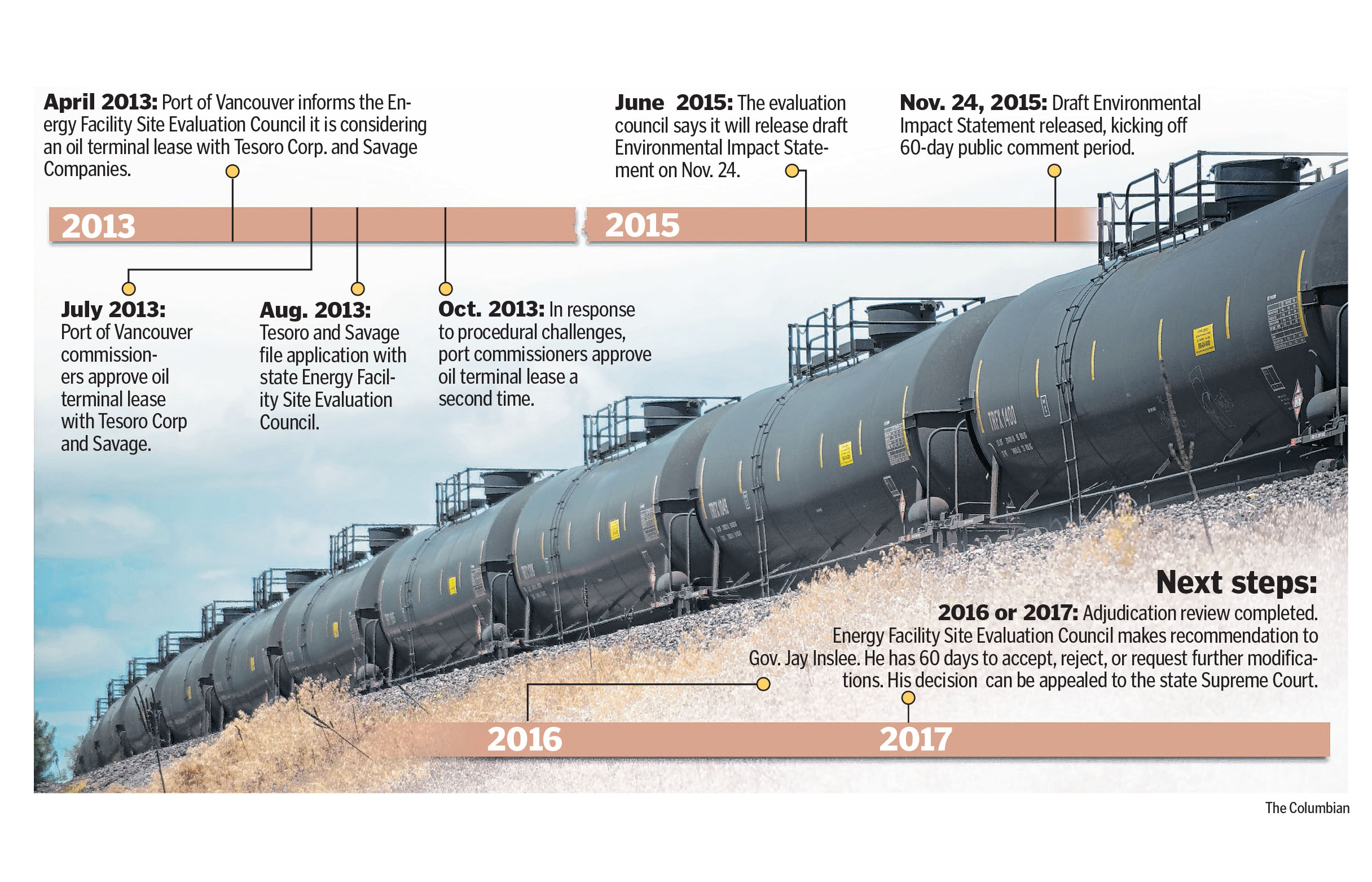Washington’s review of major energy facilities is unlike that of any other state. It relies on an appointed body of government officials, called the Energy Facility Site Evaluation Council, to examine major proposals and produce environmental impact statements that are advisories to the governor. The process can be exhaustive, but it’s intended to minimize politics and provide a fair and balanced evaluation of major energy projects. While the public is invited to participate, the highly technical process is fertile ground for attorneys and advocacy organizations.
It’s in this context that the proposed oil terminal at the Port of Vancouver, controversial from the time it was first announced in 2013, will be in the news in a big way for the next two months. The evaluation council’s release on Nov. 24 of a draft Environmental Impact Statement on the proposed oil terminal launched a 60-day public review process that invites citizens to raise their voices about the giant project that would put Vancouver at the nexus of West Coast oil transport.
The environmental review examines the proposal by Tesoro Corp., a petroleum refiner, and Savage Cos., a transportation company, to build a terminal at the Port of Vancouver that would receive about 360,000 barrels of crude per day. The oil, coming from midcontinent oil fields in the U.S. and possibly Canada, would then be transferred to marine vessels and sent down the Columbia River en route to West Coast refineries.
Here’s a look at the state’s review process and how it will play out in the months ahead.
What is the Energy Facility Site Evaluation Council?
EFSEC, as it is commonly known, was created in 1970 to review proposals for nuclear power plants. Its role was later expanded into a review panel for a broader range of energy facilities of statewide significance. The review process pre-empts all local and state laws regulating such projects. The state panel considers each application based on specific laws and rules. It relies on an environmental impact statement’s analysis of a project’s positive and negative impacts on local communities and the environment, among other factors.
Has EFSEC ever reviewed an oil terminal?
No. EFSEC was created to review “generating facilities.” But the Legislature later expanded the council’s authority to include reviews of oil facilities in response to public opposition to a large refinery built on the Puget Sound and concerns about oil shipments on state waterways.
Who serves on the council?
It is led by a chair who is appointed by the governor and approved by the state Senate. The current chairman is Bill Lynch, a former senior staff counsel for the state House of Representatives. Six other members represent state agencies. They are appointed by top state administrators based on their expertise in areas relevant to the proposal. Other state agencies can “opt in” as EFSEC members when the agencies feel it is important. For the Tesoro-Savage proposal, the Washington State Department of Transportation has “opted in” because the oil would be shipped by rail. Local governments within the area of the proposed project are automatically members, including the city of Vancouver, Clark County, and the Port of Vancouver. The port representative is ex-officio and cannot vote.
How does the council conduct its evaluation?
The council’s first step is to determine whether it has all the information it needs for its review. Once it has that information from the applicant, it develops a draft environmental impact statement. With the Tesoro-Savage proposal, the evaluation council hired the independent consulting firm Cardno Entrix to prepare the draft environmental impact statement. The Nov. 24 release of that document moved the process into a new 60-day public review period.
What happens during the public review period?
The public has until Jan. 22 to submit comments to EFSEC. Public hearing meetings are set for Jan. 5 and 12 in Clark County and another will be held Jan. 14 in Spokane Valley. Project applicant Tesoro-Savage, which goes by the name Vancouver Energy, as well as local governments and advocacy groups for and against the project, may comment on issues addressed in the draft environmental impact statement. The response could be massive: the evaluation council received more than 30,000 public comments on the scope of its study before it even launched its review. And a anti-terminal group called “Stand Up to Oil” last week announced plans to stage a protest and pack the hall at the Clark County meetings.
What comes after the public comment period?
EFSEC uses an adjudicatory proceeding similar to a trial, with an administrative law judge as presider.
The applicant is required to “prove” its application satisfies law and regulations. Government entities and organizations recognized as intervenors will be allowed to participate. A designated “Counsel for the Environment” is charged with representing the public interest in protecting the quality of the environment. Matthew Kernutt, a state assistant attorney general, is the counsel for the environment in the Tesoro review process. His charge is to look out for the state’s overall environmental interests.
In this phase of the review process, the applicant may amend its application to address issues raised in the proceeding. It also can attempt to reach settlements on individual issues or between parties, but those must be approved by EFSEC. Council members, who in effect function as judges in the proceedings, make a recommendation to the governor based on its own rules and the final environmental impact statement. That recommendation takes the form of a proposed “Order with Findings of Fact and Conclusions of Law.”
What are the governor’s options?
The governor — in this case, Jay Inslee — has 60 days to make a decision. He can accept or reject the EFSEC recommendations, or he can remand the recommendation to the council with recommended changes or for further study, which could add another year or two to the review.
Once the governor acts, his decision can be appealed directly to the Washington Supreme Court.
How long will all of this take?
No one knows, since there are some conflicting timelines in the review process. Expect the current review of the draft environmental impact statement to take perhaps until mid-2016. After that, it’s anyone’s guess.
How can I comment on the draft environmental impact statement?
At a public meeting (orally or in writing):
In Clark County: 1 to 4:30 and 6 to 11 p.m. Jan. 5, and 5 to 11 p.m. Jan. 12 Clark County Event Center at the Fairgrounds, Hall B, 17402 N.E. Delfel Road, Ridgefield.
In Eastern Washington: 5 to 11 p.m. Jan. 14, Centerplace Regional Event Center, 2426 N. Discovery Place, Spokane Valley.
Columbian business editor Gordon Oliver and reporters Brooks Johnson and Lauren Dake contributed to this report.




